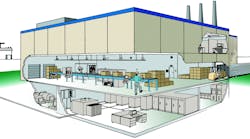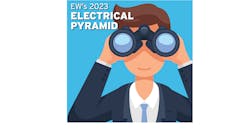Part one of “The Electrical Marketplace” in Electrical Wholesaling's July issue (page 34), covered full-line electrical distributors, the largest channel for the sale of electrical products and hybrid distributors. Although most electrical products are sold through full-line electrical distributors, many other sources of supply exist for electrical products. This article will focus on those other sources of supply.
PRODUCT NICHE DISTRIBUTORS
More than a dozen distinct types of electrical product specialists exist. They concentrate on many different products, including lighting fixtures, motors, automation products, lamps, industrial controls, wire and cable, energy-conservation products, utility products, datacom products, premises-wiring equipment, fuses and electrical insulation materials. Some of these distributors are strictly distribution firms, and do not handle any design, installation or repair capabilities. Others, such as automation specialists, energy-service companies and motor repair shops, offer these other services along with distributing products.
RESIDENTIAL LIGHTING SHOWROOMS
As much as full-line electrical distributors complain about Home Depot and other home centers, residential lighting specialists have an even bigger battle on their hands with home centers. Walk into virtually any home center and at least half — if not more — of the total square footage of floor space devoted to electrical products is soaked up by residential lighting fixtures. What hurts showrooms even more is the lighting fixtures and ceiling fans that hang on the walls and ceilings of home centers are some of the premier lines.
Another seemingly perpetual challenge in this market is the problem with knock-offs, where some industry leader comes out with an innovative lighting fixture design, only to be soon followed by an imitation from offshore.
Savvy showrooms compete by concentrating on niche products, such as chandeliers; offering enhanced lighting packages to the new construction market; working directly with builders to have their products built into model homes; training their employees as lighting experts through lighting courses offered by manufacturers and the American Lighting Association, Dallas; and working harder than ever to target the high-end residential market, where home centers are still weak.
Product focus: Interior and exterior lighting for homes. A lighting showroom's mix of products tends to focus on high-end products such as the latest styles in chandeliers, sconces; halogen lamps and lighting fixtures for kitchens, baths and other interior applications; and landscape lighting.
Primary customers
Home owners, interior designers and builders.
Key trade group: The educational programs the Dallas-based American Lighting Association provides its 1,160 members help lighting showrooms compete with home centers and other sources of supply. Contact info: 800-274-4484; www.americanlightingassoc.com.
LAMP DISTRIBUTORS
It may surprise some people to discover that many lamp specialists sell a lot more than lamps. It's not uncommon for these companies to sell energy-efficient lighting systems, including ballasts, reflectors and lighting fixtures, too. As more customers upgrade to energy-efficient lighting systems with long-life lamps that don't require replacement as often, the core maintenance business will slow down. What's next for lamp specialists? Some are looking at the residential market. With about 50 or so lamp sockets in each home, there's plenty of opportunity for the sale of more energy-efficient incandescent lamps, compact fluorescent alternatives and halogen lighting products.
Product focus
Energy-efficient lamps and specialty lamps, ballasts, reflectors and lighting fixtures for audio/visual, stage/studio, miniature or other specialty lighting applications.
Primary customers
Retail stores and “Main Street” businesses, commercial and industrial users.
National association
The National Association of Independent Lighting Distributors (NAILD), Buffalo, N.Y., has 180 members. Contact info: (716) 875-3670; www.naild.org.
WIRE AND CABLE DISTRIBUTORS
Wire and cable distributors were perhaps the first of the product specialists in the electrical market. Since this product specialty has been around the longest, it has also evolved the furthest. In its development, one may see some trends that could occur in other specialty product channels. For instance, the wire and cable channel has produced two of the larger distributors of electrical products: Anixter Brothers Inc., Skokie, Ill.; and Houston Wire & Cable Inc., Houston, Texas.
Other wire and cable distributors on EW's Top 200 list include Communications Supply Corp., Stamford, Conn.; Omni Cable Corp., Westchester, Pa.; Windy City Wire, Hillside, Ill.; Electro-Wire, Wood Dale, Ill.; JCH Wire and Cable Inc., North Las Vegas, Nev.; and A.E. Petsche Co. Inc., Arlington, Texas. Wire and cable specialists have the interesting perspective of being involved in both the more traditional products, like power or control cable, as well as products on the fast-growth track, like voice/data.
Product focus
Depends on customer mix. Specialists that sell primarily to other distributors often concentrate on hard-to-find or oddball wire; companies that go after the end user will have a much broader product mix. Other companies specialize in low-voltage wire and cable for the datacom, telephone, computer, security and signaling markets.
Primary customers
A few companies, like Omni Cable, sell exclusively to other electrical distributors; most sell at least in part to a broad range of end users.
Number of locations
A count of these specialists is tougher to come by than for any other product focus because of a lack of a national association of wire distributors, the economic conditions in the wire industry that have driven some companies out of business, and the number of startups in the fast-growing datacom end of the business. Estimates range from 100 to 200 wire specialists, depending on your definition of a wire specialist (many of these companies do some manufacturing or relabeling).
National association
None.
UTILITY DISTRIBUTORS
Most of the action for utility distributors is in products for the construction and maintenance of local distribution systems. This mix of products depends on whether the distribution systems in a distributor's market are underground, overhead or a combination of both. Some distributors of utility products pool their inventories to help each other when storm damage exceeds a member's inventory capabilities.
The utility industry has seen its share of mergers and acquisitions over the past few years. The consolidation of the utilities themselves is well-documented, and regional utilities in search of a larger user base have gobbled up dozens of smaller utilities.
Utilities are searching for more profitable uses of capital in new markets. At least one power company is quietly expanding its contracting services and has acquired several relatively large electrical contractors. MDU Resources Group Inc., Bismark, N.D., has emerged as a force to be reckoned with in the electrical contracting business through the acquisition of three electrical contractors in 2001. The company, with $2.2 billion in sales from a diverse assortment of energy holdings, construction companies and related businesses, bought Bell Electrical Contractors Inc., St. Louis; Capital Electric Construction Co. Inc., Leavenworth, Kan.; and Oregon Electric Construction, Portland, Ore. Its stable of electrical contractors also includes Wagner and Smith, Dayton, Ohio; International Line Builders, Portland, Ore.; Harp Line Construction Co., Kalispell, Mont.; and Pouke and Steinle, Riverside, Calif.
Acquisitions and mergers are reshaping the utility market on the electrical supply side, too. Hughes Supply Inc., Orlando, has always had a strong base in the utility market. In 2002, the company acquired Utiliserve, Corinth, Texas, which had been on its own quest for growth by acquisition since its inception in 1999. Utilserve purchased Temple Inc. of Corinth; Vanyo Inc., Somerset, Pa.; Power Supply Inc., Matthews, N.C.; and Rigby Electric, Kingstree, S.C. At the time of its acquisition, Utiliserve had 210 employees and sold $214 million in utility supplies through 30 locations.
Product focus
Products include pole-line hardware, high-voltage wire and cable, transformers, fuses, cutouts, panelboard equipment and safety supplies, as well as MRO supplies such as metering equipment, tools and replacement lamps for use at generating plants.
Primary customers
Co-op utilities, Rural Electrical Associations (REAs), municipal utilities and investor-owned utilities.
National association
The 17-member National American Association of Utility Distributors (NAAUD), Lady Lake, Fla., is a group of distributors nationwide with $1.4 billion in combined utility product sales that stock and share $180 million of inventory in 170 locations across North America to service storm emergency needs. Contact info: (352) 259-3999; www.naaud.com.
SERVICE/PRODUCT NICHE SPECIALISTS
The distribution/service companies have a heavy emphasis on design, installation or repair. Although they sell electrical supplies, product sales may not be their primary function. These companies focus on providing a complete service solution to their customers. Here's how the sale of electrical products fits into the package of services that distribution/services companies offer.
INDUSTRIAL AUTOMATION DISTRIBUTORS
The technological shockwaves rocking computer hardware manufacturers, where yesterday's breakthrough product is tomorrow's dinosaur, are felt in the close-knit high-tech market, too. Take the programmable logic controller (PLC), the product most responsible for bringing the power of computers to individual manufacturing processes on the factory floor. In little more than a decade, the PLC has gone from the leading edge of technology to a stepchild overshadowed by the brainpower of the custom application software that tells these devices what to do.
As this market has evolved, so have the purchasing habits of customers, who, to the frustration of distributors, are shopping their quotations for complex packages of products, services and training much more than ever. Years ago, this market was known as a haven for 30-percent-plus gross margins, but in recent years, margins on some projects have hit the levels common in more traditional product markets. Online supply sources such as www.automationdirect.com have added to the turmoil in this market.
The constant technological innovations in industrial controls shape the product specialties of these companies. In the past few years, some have added expertise in bar coding, as well as motion and positioning products.
Product focus
Control products such as PLCs, sensors, variable-speed drives, machine vision systems, bar-coding equipment and related automation products.
Primary customers
Industrials involved in virtually any manufacturing process and original-equipment manufacturers (OEMs), particularly machine-tool builders.
National association
Over 250 automation distributors belong to the Association for High Technology Distribution (AHTD), Philadelphia. Contact info: (215) 564-3484; www.ahtd.org.
MOTOR SPECIALISTS
Motor distributors continue to move toward more motor sales from their roots as repair shops. As it got more expensive to repair motors, customers bought new ones instead. In fact, many motor distributors find that in addition to selling replacement motors and offering predictive maintenance services, they must also sell related energy-saving variable-speed drives and other motor controls.
Motor distributors often call on many of the same customers as industrially oriented electrical distributors, and are well aware of industrial customers' concerns regarding declining electrical maintenance budgets staff cuts, and the need for preventive maintenance of a facility's electrical system to slash down time. Motor distributors also have some of the same concerns as electrical distributors with new competitors coming into their markets from outside the traditional channel. In the case of the motor distribution market, motor distributors are seeing power transmission distributors expand into their territory.
Relatively few full-line electrical distributors (with Kirby Risk Electrical Supply, Lafayette, Ind., being a notable exception) sell or repair motors. Many of the better-known motor distributors are members of the Electrical Apparatus Service Association (EASA), St. Louis, Mo. If you need to know more about the motor market, EASA offers “State of the EASA Industry,” a free white paper on the motor market at www.easa.org. Published by Michael Marks of The Indian River Consulting Group, Melbourne, Fla., the 74-page white paper does a terrific job of exploring the key concerns of motor distributors, their vendors and customers.
Product focus
Motors, starters, drives and related industrial controls.
Primary customers
Companies of all sizes in the industrial and commercial market.
National association
With 2,150 members in 50 countries, Electrical Apparatus Service Association (EASA), St. Louis, Mo., is the motor industry's largest trade association. Contact info: (314) 993-2220; www.easa.org.
VOICE/DATA SPECIALISTS
No two companies are exactly alike in the datacom arena. The players include large distributors that have been in the market for years like Anixter Inc., Skokie, Ill., and Graybar Electric Co., St. Louis; wire specialists that are part manufacturer; distributors that build small quantities of cable/connector assemblies; regional companies that are subsidiaries or separate business units of full-line electrical distributors; and small companies that go national with toll-free telephone numbers and next-day delivery.
Product focus
Wire and cable, connectors and other networking equipment for computer, telephone and video installations.
Primary customers
Any building with computer, telephone or video systems. Largest customers include computer-intensive service companies, hospitals and industrials.
National association
No truly national distributor association, but datacom distributors are often members of BICSI, Tampa, Fla., the largest trade association in the voice/data market. BICSI provides certification training in this market. Contact info: (813) 979-1991; www.bicsi.org.
ENERGY-SERVICES COMPANIES (ESCOS)
ESCOs offer the most sophisticated package of design, technical assistance, audit and, in some cases, installation services in the energy market. Relatively few of them function as distributors in the same sense as the other product specialists mentioned here because their primary interest tends to be in design and installation, not in supply. If ESCOs use subcontractors for installations, they often leave the purchasing up to the discretion of these companies. As electrical distributors who have ESCOs in their markets will tell you, ESCOs have a lot to say about what products are used in the installation of systems.
ESCOs started out in markets with big utility-rebate programs because they helped customers get the most out of them. When ESCOs engage in what is called “performance contracting,” they help a customer purchase the products, and the customer then pays them back based on the electrical energy-use savings from these more efficient products.
Public utilities like what they see in the ESCO business, and many utilities have purchased ESCOs to handle the design and installation of energy-efficient electrical systems, potentially forming a new channel to the market competing with the more traditional distributor-contractor relationship.
The electrical distributors with the best grip on the energy market see ESCOs as customers, not competitors. Electrical distributors can provide ESCOs with a reliable, full package of energy-efficient electrical products for their design and installation projects. As this channel evolves, though, electrical distributors may see more ESCOs buying direct from manufacturers, particularly with those companies owned by utilities. Utilities often buy direct because they purchase electrical products in huge quantities; it's possible utilities would continue this practice with the products that their ESCOs install.
Product focus
Relatively few ESCOs are interested in stocking equipment, but the ones that do carry inventory stock a full range of energy-efficient products, including lighting fixtures, lamps, reflectors, variable-speed drives and other types of energy-efficient products.
Primary customers
Retail, commercial, industrial, institutional and government facilities.
Number of locations
100 to 200 companies.
National association
National Association of Energy Service Companies (NAESCO), Washington, D.C., (202) 822-0950; www.naesco.org
LIGHTING MAINTENANCE COMPANIES
The companies that install and maintain lighting systems are an interesting mix of contractors with a sideline in lighting maintenance; maintenance specialists that compete with contractors; and, on occasion, sources of supply for lighting products that compete with electrical distributors. One firm, Sylvania Lighting Services, Danvers, Mass., is actually a wholly-owned subsidiary of lamp manufacturer Osram Sylvania.
The companies focus on relamping large commercial projects and other large facilities, outdoor lighting and the lighting of parking lots and signs. Along with the installation and maintenance of lighting systems, these companies usually provide facility audits for customers so they can project potential savings by relamping.
National association
International Association of Lighting Management Companies (NALMCO), Des Moines, Iowa; (515) 243-2360; www.nalmco.org
RETAILERS SELLING ELECTRICAL SUPPLIES
After full-line electrical distributors, the next most visible way for electrical products to get to market is the retail channel. Home centers, hardware stores and residential lighting specialists account for close to $10 billion in total sales of electrical products. Department stores and other retail shops sell some lighting products, too.
THE HOME DEPOT INC.
Home Depot's impact as a channel for electrical product sales has never been greater. The company sells an estimated $3 billion in electrical products. Those sales include one out of every five light bulbs and 50 percent of all ceiling fans sold in the United States — not to mention 40 percent of all consumer power tools in the United States. Big Orange had 1,788 locations in the United States, Canada and Mexico, $64.8 billion in 2003 sales and 300,000 employees.
The company's role as a competitor to electrical distributors could increase even further if it decides to get into the electrical distribution business. That idea isn't as far-fetched as one might think — in 1999 the company purchased one of the largest retail lighting distributors in the United States, Georgia Lighting Supply Co., Atlanta. Through its The Home Depot Supply business unit, the company owns Your Other Warehouse (YOW), a plumbing distributor, that stocks 40,000 products from 100 vendors; Maintenance Warehouse, a wholly owned distributor of maintenance, repair and operations (MRO) supplies; and Apex Supply Co., a distributor of plumbing, HVAC and other related products in the Southeast.
Home Depot covets professional customers because of their spending power; pro contractors represent approximately 30 percent of the company's $64.8 billion in sales. According to the 2003 Home Depot annual report, for every dollar spent by a do-it-yourselfer, a professional customer spends approximately $3.
Home Depot has also moved aggressively into installation services by acquiring contracting firms that specialize in flooring, windows and countertops. Last year, its installed-sales business totaled $2.8 billion. It's not much of a stretch to imagine they one day might acquire electrical contracting firms to provide electrical installations.
LOWE'S CO.
Lowe's, Mooresville, N.C., is providing some stiff competition to Home Depot. The company enjoyed an 18.1 percent 2003 sales increase to $30.8 billion. Lowe's has more than 1,000 stores with 160,000 employees in 45 states, and continues to build new stores like crazy. It opened 130 stores in 2003, plans to open 140 stores in 2004, and 150 stores in 2005. The company was traditionally strongest near its North Carolina roots in the Southeast and throughout the Sunbelt, but it's now taking dead aim at all metropolitan markets with more than 500,000 in population, and plans to open 60 stores in the New York metropolitan area in a $1 billion expansion.
In contrast to Home Depot, Lowe's provides its installed services through third-party contractors. Lowe's hopes its installed business sales hit $2.5 billion by 2005. The company doesn't focus on pros as intently as Home Depot, but contractor sales account for 20 percent of its total annual sales.
OTHER HOME CENTERS
With Home Depot and Lowe's dominating the home improvement channel with combined 2003 sales of $95.6 billion, it's easy to forget that plenty of other home centers continue to thrive. In Home Channel News' annual “Top 500” listing of the largest retailers in the home improvement market, 81 home centers are listed. Most of the companies have sales ranging from $22 million to $100 million, but there's one more giant home center to consider: Menards, Eau Claire, Wis., with $6 billion in 2003 sales, 115 locations and 80,000 employees.
However, don't underestimate the size of Home Depot and Lowe's in the home improvement market. In 2003, total sales through home centers, hardware stores, building material dealers and other retailers on Home Channel News' listing hit $186.6 billion. Home Depot and Lowe's accounted for 51 percent of that total.
HARDWARE STORES
Electrical products are one of the core product groups for hardware stores, and most of these retail outlets will have at least one or two aisles of the most commonly needed electrical supplies. In 2004, hardware stores will sell $1.35 billion in electrical products — 4.75 percent of the average hardware store's total sales, according to Do-It-Yourself Retailing magazine. Hardware stores don't target electrical contractors and other professional contractors as much as home centers, although it's quite common to find some tradespeople in hardware stores picking up a few items.
Product focus
Hardware stores stock very basic electrical products for residential applications Number of locations. According to Do-It-Yourself Retailing magazine's research, 20,200 hardware stores exist in the United States.
Primary trade association
National Retail Hardware Association (NRHA), Indianapolis; www.nrha.org.
DISTRIBUTORS FROM OTHER TRADES
A wide range of distributors from other trades sell electrical supplies in addition to their core product offering. These companies include distributors of industrial supplies, tools, electronic components, power transmission products, plumbing equipment and mill supplies. Of all these trades, industrial distributors probably sell the most electrical products. That's because their core customers — factories that need maintenance products to keep their operations up and running — are glad to pare down the transaction costs by dealing with an industrial distributor who can supply MRO electrical products, and support those products with the necessary service, inventory, delivery and technical expertise.
Johnstone Supply, Portland, Ore., is an interesting distributor from outside the electrical industry that has is a major distributor of electrical products. Along with electrical products, the company's 280 locally owned branches sell heating and air conditioning supplies, plumbing equipment, boilers, water heaters, motors and other industrial maintenance supplies.
OTHER CHANNELS
A handful of other channels exist, including Web-based companies; alliances among distributors from different trades to service the maintenance, repair and operations (MRO) product needs of industrial customers with a single-source solution; and direct sales from manufacturers. Part one of this article covered the other channels of electrical supplies.
Conclusion
The different channels to market for electrical supplies that make up the “bricks” in Electrical Wholesaling's Electrical Pyramid will continue to evolve over the years. Newer channels will continue to emerge. But to survive, a new channel must prove that it's a more effective route to the market than a traditional source of supply that has survived for over 100 years and continues to be the channel of choice: the full-line electrical distributor.








